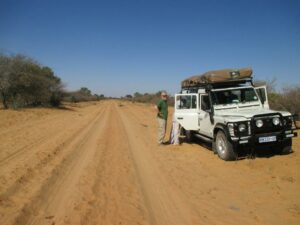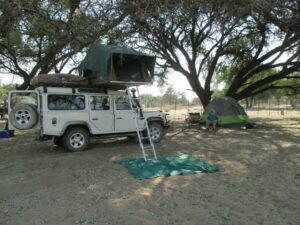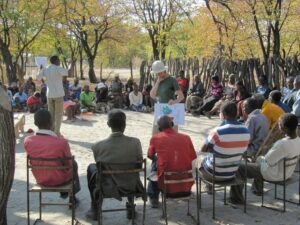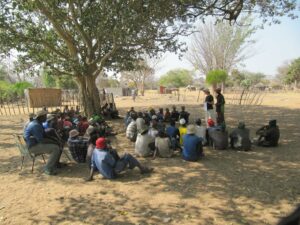Giving Them Their Genetic History: Returning the Results of Molecular Anthropological Studies to Southern Africa
A Final Report from Engaged Anthropology Grant recipient Brigitte Pakendorf, Dynamique du Langage, CNRS and Université Lyon 2, awarded in March 2015.

I had received a Post-PhD grant from the Wenner-Gren Foundation in 2012 to cover part of the costs involved in analysing Y-chromosomal sequence variation among populations of southern Africa, particularly among those who speak so-called “Khoisan” languages. Under the label “Khoisan” I subsume the indigenous languages of southern Africa that are characterized by a heavy use of click consonants and that do not belong to the Bantu family of languages. These Y-chromosome analyses were part of a larger project on the genetic history of the Khoisan-speaking peoples. Since this project is nearly completed, I decided to return to Botswana and Namibia to explain the results to the people whose genetic history we had studied. I undertook this return trip together with my close collaborator, Mark Stoneking from the Max Planck Institute for Evolutionary Anthropology, who had accompanied me to Namibia in 2011 to collect samples and who has been deeply involved in the genetic analyses. Our plan was to visit as many of the communities that had participated in the study as possible to explain to them in person what we had found out about their history.
It should be noted that the original field trips to collect saliva samples in Botswana and Namibia had taken six and seven weeks, respectively, whereas we now had only six and a half weeks at our disposal for the entire trip. Therefore, we were not able to visit all the communities in person, but I sent written reports to those that we could not reach for lack of time. For the communities settled in Botswana, these written reports were translated into Tswana, the lingua franca of Botswana, while for the communities settled in Namibia they were translated into Afrikaans, still widely used in that country; we sent both the English original and the translated version of each report. In these reports – both the written and the oral that formed the basis of our community meetings – I tried to provide not only information concerning the prehistory of the Khoisan-speaking peoples and their Bantu-speaking neighbours in general, but also specific results concerning the genetic history of each individual ethnolinguistic group.

We travelled from Johannesburg through Botswana and Namibia to Windhoek, starting on July 7th and arriving on August 17th, 2015 and covering approximately 10,000 km in total in a Landrover driven solely by Mark, which we were able to rent thanks to the grant from the Wenner-Gren Foundation. The other expenses incurred during this trip were covered by a separate grant awarded by the Laboratory of Excellence “ASLAN” of Lyon.
In order to be as efficient as possible, we had set up a very tight itinerary and I had sent letters ahead of time to all of the communities for whom I had addresses, informing them of the time and date we proposed to come; we further arranged meetings by phone on the ground where possible. Unfortunately, not all of our letters arrived at their destination, so that there were several communities who were unaware of our plans until we arrived. In several of these it was therefore impossible to organize a community meeting to explain our results. Nevertheless, of the nearly 40 communities that we visited during our trip, we were able to explain our findings in personal meetings to 28.

In order to make the rather complex material more accessible to people who often have only a relatively low level of education, we had brought some illustrations, with the help of which I tried to explain how we can study the (genetic) history of an ethnolinguistic group using saliva samples as well as what we found. In Botswana, my explanation was translated into Tswana by our assistant Blesswell Kure, with a further translation into the local language by a member of the community where needed. In Namibia I conducted the meetings mostly in Afrikaans, which is often understood better than English; again, where needed, a community member would translate what I said into the local language. The size of our audiences in the villages ranged from 10 to approximately 70, with on average 30-40 people listening. Where we were unable to explain our results in person, we left written reports in the hopes that in this way the information concerning our results would spread via the literate community members. We furthermore left these written results after each community meeting, and will be sending more of these to communities and individuals who had requested this.

In addition to explaining our findings to the communities who had participated in our study, we also gave lectures in Johannesburg, Gaborone, and Windhoek. These targeted different audiences: geneticists at the Sydney Brenner Institute in Johannesburg, interested academics from various fields at the University of Botswana in Gaborone and the University of Namibia in Windhoek, and the general public at the Namibia Scientific Society (also in Windhoek). We estimate that in total we shared our results directly with approximately 1,000 people. Furthermore, we gave a television interview in Gaborone and a radio interview in Windhoek.
While the response among the communities was generally very positive, there were also some who made it very clear that knowing about their genetic history – which often entails events that took place thousands of years ago – is entirely irrelevant to their daily struggle for a decent living and basic political rights, and who would have preferred material support over abstract knowledge. Nevertheless, in general the people we met were very appreciative of our efforts to share the findings from our study with them, and most of them were very interested in our results. Thus, in several cases people started avidly reading the written reports that we had prepared as soon as we distributed them after each meeting, and as I said above, many have requested their own personal copy. This underlines the importance of returning the results of scientific studies to the people involved, and the Wenner-Gren Foundation is to be highly commended for taking the initiative with their “Engaged Anthropology” funding programme.